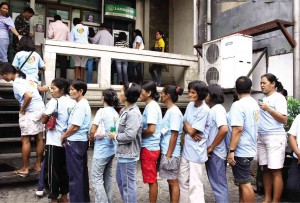DSWD chief: Appearances don’t define poverty

CCT beneficiaries didn’t wear tattered clothes—which Social Welfare Secretary Corazon “Dinky” Soliman said was a mistaken basis for defining poverty—as they line up before an ATM in Lucena City, in this photo taken in 2011. DELFIN T. MALLARI JR./INQUIRER SOUTHERN LUZON
BAGUIO CITY—Social Welfare Secretary Corazon “Dinky” Soliman, still stung by a Commission on Audit (COA) report saying that the government’s cash incentive program for the poor has been ineffective, said here that government auditors had apparently made a mistake in defining poverty in the Philippines by judging a book by its cover.
“People assume an individual is not poor and is a salaried worker, when he or she dresses well and owns nice clothes,” said Soliman at a meeting with Cordillera region officials and a press conference that followed it.
“But when we see [beneficiaries of the government’s Conditional Cash Transfer or CCT program well-groomed] while standing in line at the bank to receive their grants, we must assume they cleaned up because they do not want to stand out in a bank,” she said.
“We have to break these assumptions about poor Filipinos,” she added.
Biased view
Article continues after this advertisement“Sometimes this idea of what a poor person looks like is a very biased way of looking at the world,” said Soliman, whose department spent P62.6 billion this year on CCT and is getting up to P64.7 billion next year for the program.
Article continues after this advertisementThe CCT entitles a poor household to as much as P1,400 in monthly cash grants on condition that recipients make sure their children [up to three, at least] stay in school and get regular medical checkups in government clinics.
In an audit report on CCT in 2013, COA questioned the program’s progress.
The report challenged the Department of Social Welfare and Development’s (DSWD) list of CCT beneficiaries because of a discrepancy of 364,036 households, which auditors did not find on the list of poor households made in 2009 by the National Household Targeting System (NHTS).
Soliman said there is no discrepancy. She said COA was informed in September that 107,373 households were on the NHTS list and in the agency’s Pantawid Pamilyang Pilipino Program, which releases CCT monthly grants.
She said the remaining 256,663 households benefiting from CCT are on a separate list for a modified CCT program, which covers homeless families who are not on the 2009 NHTS list. It also covers indigenous peoples.
The COA report contested DSWD’s classification of 21,117 households as poor.
Soliman said DSWD had verified that out of these, 21,089 households that COA defined as not poor were, indeed, poor. She said the DSWD is checking the status of the other 28 households.
Houses’ appearance
She said government auditors had inspected the houses of some of the beneficiaries and concluded that they do not fit the conventional definition of poor.
“The trouble with this thinking is that households who were registered as CCT beneficiaries in 2009 would have improved their homes and lives, otherwise the program had not been effective,” Soliman said.
“So if you judge them according to how they were when they [became eligible for CCT], it could be their homes started out as shanties and are now reinforced with galvanized-iron sheets,” she said. “From the point of view of COA, that does not reflect poverty,” she added.
Social workers, said Soliman, tried to explain this to auditors.